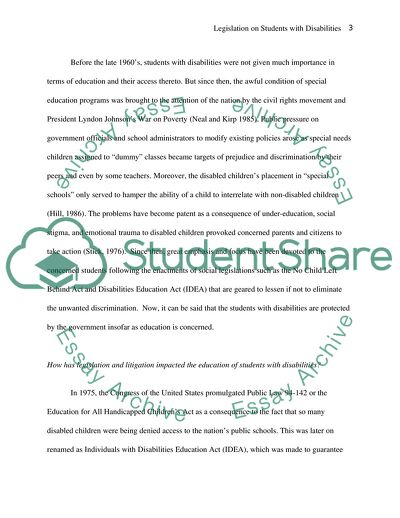
- Home
- Free Samples
- Premium Essays
- Editing Services
- Extra Tools
- Essay Writing Help
- About Us
- Studentshare
- Subjects
- Miscellaneous
- Attitude, Legislation, and Litigation
Attitude, Legislation, and Litigation - Essay Example

- Subject: Miscellaneous
- Type: Essay
- Level: Undergraduate
- Pages: 4 (1000 words)
- Downloads: 0
- Author: zbuckridge
Extract of sample "Attitude, Legislation, and Litigation"
Such kind of discrimination against disabled children has continued to be remained unchecked until the 1960s. For instance, the Supreme Court for the State of Illinois, made a decision in 1958 that legislation requiring compulsory education for children and establishing programs for disabled children did not necessitate that public education be provided for a mentally impaired child (Daniel, 1997). There are now laws such as the No Child Left Behind Act and Disabilities Education Act (IDEA) that protect the welfare of the disabled children.
However, their legal provisions are ambiguous that could have lead to different interpretations of several courts of law. But at the end of the day, the bottom line of such advocacy and policies is to provide quality education for disabled children through appropriate programs (Daniel, 1997). Before the late 1960’s, students with disabilities were not given much importance in terms of education and their access thereto. But since then, the awful condition of special education programs was brought to the attention of the nation by the civil rights movement and President Lyndon Johnson’s War on Poverty (Neal and Kirp 1985).
Public pressure on government officials and school administrators to modify existing policies arose as special needs children assigned to “dummy” classes became targets of prejudice and discrimination by their peers and even by some teachers. Moreover, the disabled children’s placement in “special schools” only served to hamper the ability of a child to interrelate with non-disabled children (Hill, 1986). The problems have become patent as a consequence of under-education, social stigma, and emotional trauma to disabled children provoked concerned parents and citizens to take action (Stick, 1976).
Since then, great emphasis and focus have been devoted to the concerned students following the enactments
...Download file to see next pages Read MoreCHECK THESE SAMPLES OF Attitude, Legislation, and Litigation
Constitutional & Administrative Law
Attitude, Legislation, and Litigation on Special Education
Special Education Attitude, Legislation and Litigation
Workplace health and safety
Greatest Impacts on the Criminal Justice System in Australia
Disability: Policies and Current Legislation
Non-Contractual Obligations and the Rome II Regulation
Cyber Crime Exaggeration and Legislation

- TERMS & CONDITIONS
- PRIVACY POLICY
- COOKIES POLICY